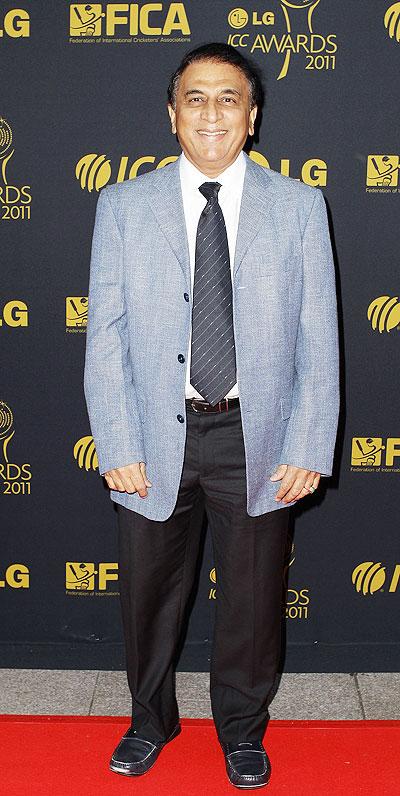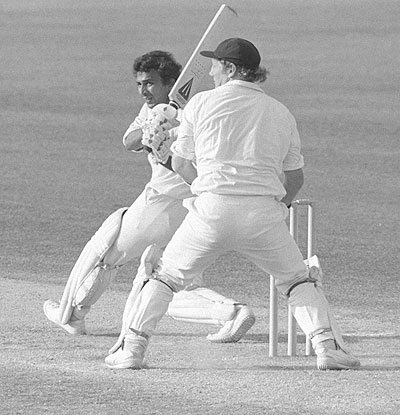 | « Back to article | Print this article |
Happy Birthday, Sunny Gavaskar!
Haresh Pandya pays tribute to the former Test run-machine who turns 63 today.
It is 25 years since Sunil Gavaskar called it a day. And twenty-five years is a very long time by any yardstick, any stretch of imagination. Yet, the world is yet to come across a Test opener who can approach the Indian in technique and temperament. It is at once a tribute to the class and quality of Gavaskar, who is celebrating his 63rd birthday today (July 10).
As an opening batsman of the highest order, Gavaskar ruled the world for 17 years -- from the day he appeared on the Test scene with a bang
(774 runs at 154.80 in the West Indies in 1971) till he felt he had had enough and hanged his prolific willow after playing a gem of an innings of 96 (out of India's disastrous innings of 204 chasing a victory target of 221) on a minefield of a pitch against Pakistan at Bangalore in 1987. There were many outstanding, world-class openers around -- Geoffrey Boycott, Glenn Turner, Roy Fredericks, Gordon Greenidge, Desmond Haynes and Graham Gooch, to name some of the prominent ones -- when Gavaskar was in his prime, but none of them had his talent and the resultant phenomenal success he achieved.
There was Barry Richards, too, but South Africa's barbaric policy of apartheid had relegated him to only first-class cricket in England and
Australia as the rainbow nation was banned from international sports not long after he had scored 508 majestic runs at 72.57 in four Tests against the mighty Australians in 1969-70 in what turned out to be his only taste of the heavyweight division of cricket. Maybe, just maybe, Richards would not have allowed Gavaskar to dominate world cricket for so many years and the way he did. But it was just not in his destiny.
Gavaskar's scientific technique made him special
What made Gavaskar so special was his scientific technique and methodical approach to almost anything he did with the bat. Hailing as he did from the Mumbai school of batsmanship founded by Vijay Merchant, Gavaskar had oodles of concentration and Promethean determination which always stood him in good stead when taking on the world's most fearsome fast bowlers.
His hawk-like eyesight helped him see the ball early and decide whether to play it defensively or strike it for runs. His trademark, copy-book straight-drive and cover-drive were the fruits of these qualities.
Being a cool customer -- at least when batting -- enabled him to build his innings brick by brick and decide further course of action at the crease. Gavaskar was a master of the waiting game, one who was never boring, unlike Boycott. In a team that depended enormously on him and his friend and brother-in-law Gundapa Viswanath in the 1970s, Gavaskar had no other option but to drop anchor more often than not. It is akin to looking for a needle in a haystack to find another instance of a cricket team relying heavily on just two batsmen for so many years.
Being an opener, and heading such a brittle batting line-up as India's in the 1970s, he had to ensure that the ball lost its shine, that the fast bowlers were tired and that there were runs on the board before he got out.
He had to bat even more defensively and seriously if he saw Viswanath being dismissed cheaply at the other end. Yet, he never let go opportunities to punish loose deliveries.
In fact, so rich was Gavaskar's repertoire of shots that he would often execute with ridiculous ease some of the most exciting strokes, including the full-blooded hook despite his lack of inches, you could ever hope to see.
Remember his 102 against Michael Holding and company that laid the foundation of India's improbable victory (chasing 400-plus in the fourth innings) at Port of Spain in Trinidad in 1976. Or remember his epic, entertaining 221 at The Oval against England in 1979 when India nearly pulled off a sensational win chasing 400-plus. One can go on and on mentioning one brilliant innings after another from Gavaskar's fabulous collection of 34 centuries in 125 Tests.
Gavaskar hardly wore a helmet during his phenomenal career
None of Gavaskar's contemporary openers had to bat under the kind of pressure did. And yet, he would hardly allow the bowlers to get the better of him and score consistently prolifically. He faced many of the world's most hostile quick bowlers; and also some of the finest spinners, including Indian masters in domestic cricket.
Besides his ability and much-talked-about technique, concentration, determination and sheer hunger for runs (read success), the beauty of Gavaskar's batting lay also in the fact that never once did he wear a helmet during his phenomenal career.
In spite of being short and without ever being equipped with a helmet,
Gavaskar successfully dealt with some of the most feared names in the field of fast bowling -- John Snow, Bob Willis, Jeff Thomson, Imran Khan, Richard Hadlee, Malcolm Marshall, Andy Roberts and, of course, Holding. And except Chetan Chauhan, who formed a fairly successful pair with Gavaskar between 1977 and 1981, he had never had a reliable opening partner. The point is none of the aforementioned openers had Gavaskar's disadvantages.
Gavaskar was not just a most capable and productive run-machi#8800 he was a very attractive batsman, too, although not as artistic and stylish as Viswanath.
When he played a perfect straight-drive off a brutal fast bowler, it was difficult not to fall in love with his batting. When he played the most beautiful of cover-drives going on his keens, even connoisseurs could not help clapping wholeheartedly.
When he employed all his technical excellence, powers of concentration and steely resolve in grim adversity while surrounded by a cordon of close-in fielders with the Indian team in doldrums and the bowlers on top, even the opponents would secretly marvel at his genius.
Mind well, there were no restrictions on fast bowlers, who could bowl any number of bouncers per over. And to bat against them without a helmet on bouncy Caribbean wickets or the greentops down under with five, six, seven or sometimes even eight eagles waiting in the slips was certainly not a child's play.
West Indies, studded with a battery of awesome pace bowlers, explosive batsmen and panther-like fielders, was the team to beat in the 1970s and 1980s. And to have scored so many of his runs and centuries against the calypso charmers when others were seen struggling to make even a few says a lot about Gavaskar's batsmanship.
Gavaskar was never a defensive batsman
Contrary to popular belief, Gavaskar was never a defensive batsman. Far from it. He was a natural strokeplayer, just like Viswanath and Zaheer Abbas.
Playing for a weaker team meant invariably carrying a huge responsibility on his little but capable shoulders. If anything, he just could not be a Virender Sehwag, even for a while. He just could not afford it.
The very circumstances were such that even a batsman of Gavaskar's calibre had to curb his shots, if not his natural game, in the interest of his team. Being an artist in thrall to his genius, Viswanath just could not do so, even though he carried the same responsibility. But the difference in their success, purely in statistical terms, is obvious.
There was never a Test opener like Gavaskar during his career. Nor has there been anyone like him even 25 years after he last wielded the willow in Test cricket.
Australia in particular has produced an array of immensely gifted and successful Test openers in those years -- David Boon, Geoff Marsh, Mark Taylor, Michael Slater, Matthew Hayden, et al -- but none of them could be bracketed with Gavaskar, all things considered. Leave alone his dazzling statistics and records, many of his tours de force speak volumes of Gavaskar's genius and greatness.
And to think he announced his retirement when he was still on top of his game and was fit enough to play at least three years more.



